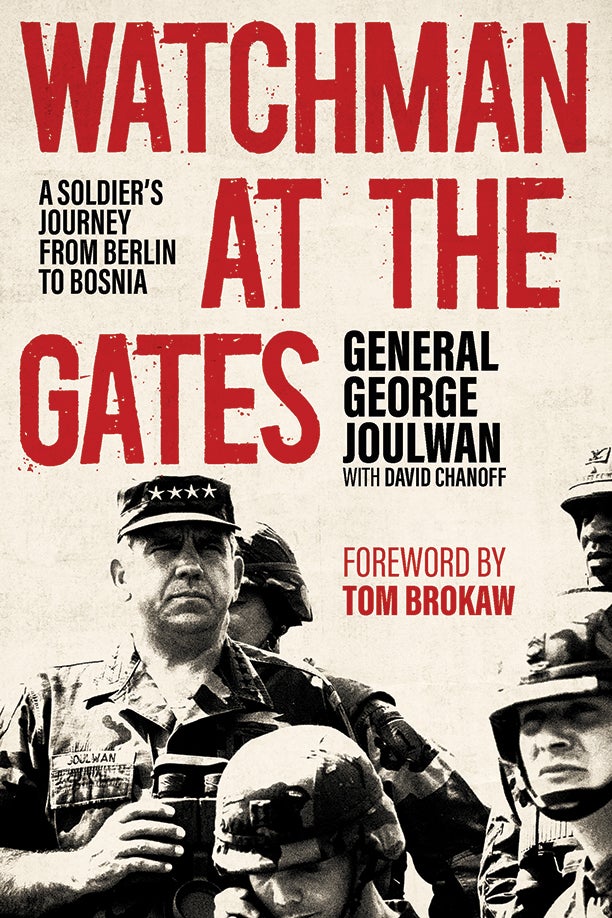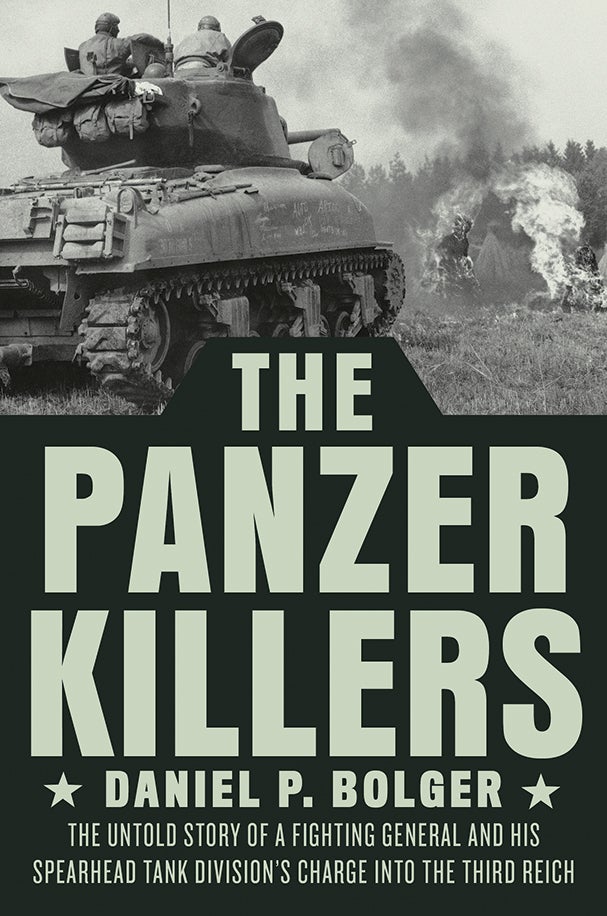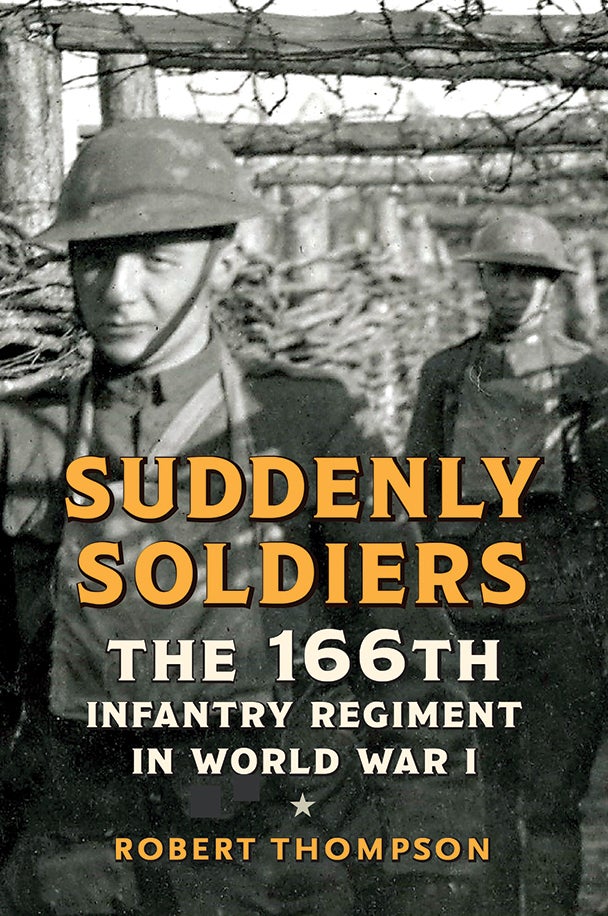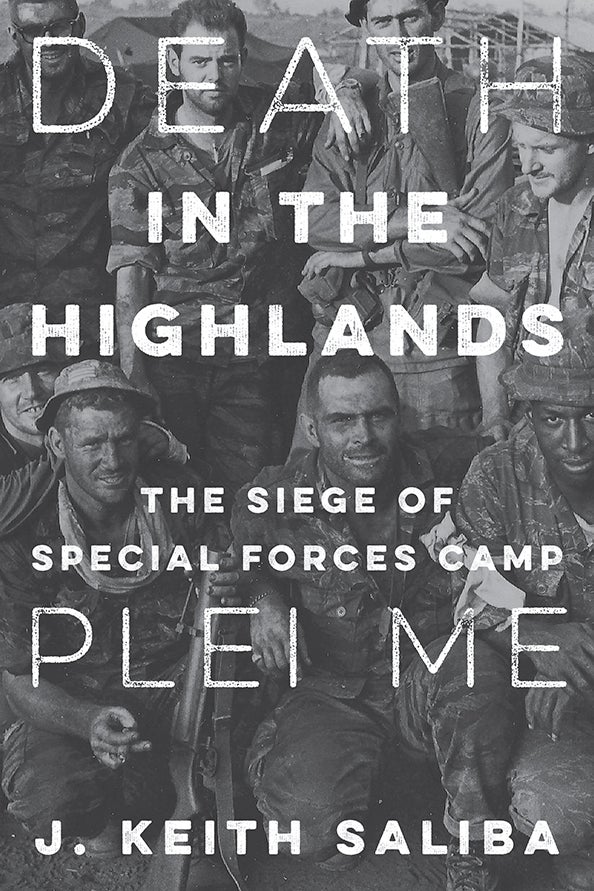June 2021 Book Reviews
June 2021 Book Reviews
Stirring Account of a Lifetime of Service

Watchman at the Gates: A Soldier’s Journey from Berlin to Bosnia. Gen. George Joulwan With David Chanoff. University Press of Kentucky. (An AUSA title). $29.95
By Brig. Gen. John Brown, U.S. Army retired
Retired Gen. George Joulwan’s Watchman at the Gates: A Soldier’s Journey from Berlin to Bosnia provides a compelling mix of history, memoir and cogent insight. It will be invaluable to anyone interested in the Army and its experiences through the last third of the 20th century.
Beyond that, the book also speaks to issues and suggests solutions that remain strikingly relevant now, a generation later. Like Scripture, the book should be read on two levels: What does it say directly, and what does it mean for all time?
Joulwan, with co-author David Chanoff, tells his story in a chronological manner, progressing through assignments, events and adventures as he encountered them. One chapter carries him through childhood, youth and the U.S. Military Academy at West Point, New York, speaking to family values en route. Eight chapters carry him from lieutenant through colonel, including representative vignettes at each stage.
Five chapters feature him at the peak of the Army profession, commanding mammoth enterprises in Latin America and Europe. The mix is a good one, flagging up the personal and developmental while also exploring his ultimate roles as a grand strategic player.
Whether speaking to his time as a lieutenant or a commanding general, Joulwan takes care to paint the larger pictures of which his service was a part. He was in Germany when the Berlin Wall went up and when it came down. His account focuses on personal experiences but also includes challenges faced by U.S. Army Europe. Similarly, Vietnam comes across as both a personal and a national endeavor.
Joulwan keeps this breadth of view while describing his service as the head of the U.S. Southern Command and then as Supreme Allied Commander Europe. His accounts of decisions at the highest echelons remain mindful of others’ experiences at the lowest.
Students of leadership will be heartened by Joulwan’s thoughtful attention to that subject. Certain “fundamental requirements” recur at each level as he progresses: clarity of mission, unity of command, robust rules of engagement and timely direction. Mentors such as Gen. William DePuy teach him to “walk the line” to assure standards and to achieve a granular view of the circumstances of soldiers. Allies and alliances figure into his reasons for success throughout his career arc. Perhaps most important, Joulwan repeatedly underscores a soldier’s need for moral purpose.
As fascinating as Joulwan’s accounts of his service in traditional rungs on the Army ladder are, some readers may be even more intrigued by his experiences off the main track. These include becoming a lightning rod for student interest while an ROTC instructor during the Vietnam era, serving as Chief of Staff Alexander Haig’s assistant in the Nixon White House as it was coming apart, and seeing such crises as Grenada, the Beirut barracks bombing and debates over the Reagan buildup from the vantage point of executive officer for the chairman of the Joint Chiefs of Staff.
These illuminate critical aspects of the relations among America’s soldiers, people and government. They also demonstrate the value of breadth in a soldier’s professional development.
I was present when Joulwan turned over command as Supreme Allied Commander Europe in 1997. It was a magnificent moment. We, as U.S. Army officers, were amid loyal allies and a successful alliance, clearly on the moral high ground, and accomplishing great things for peace and freedom.
Some of the bloom seems to have come off that rose of late. Hopefully, Joulwan’s stirring account of his lifetime of service will help inspire us to regain whatever ground we may have given up.
Brig. Gen. John Brown, U.S. Army retired, served 33 years in the Army, with his last assignment as chief of military history at the U.S. Army Center of Military History. The author of Kevlar Legions: The Transformation of the United States Army, 1989–2005, he has a doctorate in history from Indiana University.
* * *
Biography Brings Bloom to Rose’s Name

The Panzer Killers: The Untold Story of a Fighting General and His Spearhead Tank Division’s Charge Into the Third Reich. Daniel Bolger. Dutton Caliber. 432 pages. $29
By Col. Cole Kingseed, U.S. Army retired
Maj. Gen. Maurice Rose, commanding general of the 3rd Armored Division, was the most senior Jewish officer killed in action during World War II. Rose compiled a distinguished combat record in the campaigns in North Africa, Sicily and northwest Europe by the time of his untimely demise on March 30, 1945.
Despite his battlefield heroics, Rose’s name is but a footnote in history. Daniel Bolger corrects this imbalance with an engrossing biography of Rose in The Panzer Killers: The Untold Story of a Fighting General and His Spearhead Tank Division’s Charge Into the Third Reich.
Bolger is a retired lieutenant general and a combat veteran from the Iraq and Afghanistan wars (and a monthly contributor to ARMY magazine). Having commanded the 1st Cavalry Division in Iraq and having served as commanding general of the Combined Security Transition Command-Afghanistan, Bolger is eminently qualified to address armored warfare in the crucible of combat. His previous books include Americans at War, 1975–1986; Why We Lost: A General’s Inside Account of the Iraq and Afghanistan Wars; and Death Ground: Today’s American Infantry in Battle.
What makes this subject so fascinating, according to Bolger, is that Rose was one of the few American commanders who possessed “coup d’oeil, the ability to size up ground at a glance, envisioning combat moves in time and space.” Third U.S. Army commander Gen. George Patton Jr. and VII Corps commander Maj. Gen. J. Lawton Collins also had the gift.
Few senior American commanders emerge unscathed in Bolger’s narrative. First U.S. Army commander Lt. Gen. Courtney Hodges, for example, “proved obtuse, inert, and eminently forgettable, The Man Who Wasn’t There.” Gen. Omar Bradley “knew the weapons ranges and the doctrinal frontages, but found it impossible to envision it all in real dirt.”
Bolger credits Bradley and Patton for recognizing Rose’s potential and providing this energetic officer an opportunity to excel as commander of Combat Command A in the 2nd Armored Division, then as commanding general of the 3rd Armored Division. Intent on destroying the enemy, Rose led his “Spearhead” Division in the pursuit of German forces from Normandy in France to the Rhine River in Germany. For his actions in Belgium, Rose received the Distinguished Service Cross for “extraordinary heroism” and “intrepid actions, personal bravery and zealous devotion to duty.”
Once across the Rhine, Rose’s 3rd Armored Division remained in the forefront of First Army’s advance as the Allies attempted to encircle the Ruhr Pocket. A front-line commander, Rose met his fate near Paderborn, Germany, when an enemy tank commander shot him as Rose was in the act of surrendering. Rose’s death sparked a war crimes investigation. The investigator ruled that the killing was not intentional, but “made in the heat of battle.”
Bolger makes his greatest contribution to the current force when he utilizes his personal experience to enlighten readers on the intricacies of modern warfare. He provides a soldier’s view of senior commanders: They “rarely think about generals. Sergeants, lieutenants, and captains dominated the lives” of young soldiers. Bolger also explores the difference “between hearing fire (common, no problem), receiving fire (getting interesting), and taking effective fire (get down, seek cover).”
The Panzer Killers serves as a superb complement to Stephen Ossad and Don Marsh’s Major General Maurice Rose: World War II’s Greatest Forgotten Commander. By concentrating solely on Rose’s World War II exploits, Bolger has provided a valuable addition to one of the war’s most celebrated division commanders.
Col. Cole Kingseed, U.S. Army retired, a former professor of history at the U.S. Military Academy, West Point, New York, is a writer and consultant. He has a doctorate in history from Ohio State University.
* * *
‘Rainbow’ Regiment Battles Its Way Across Europe

Suddenly Soldiers: The 166th Infantry Regiment in World War I. Robert Thompson. Westholme Publishing. 264 pages. $30
By Capt. Jonathan Bratten, Maine Army National Guard
Every new work added to the collective literature of the U.S. experience in World War I is to be welcomed as the nation continues to struggle with its understanding of that war. Robert Thompson’s Suddenly Soldiers: The 166th Infantry Regiment in World War I highlights the history of the 166th Infantry Regiment during the conflict.
As part of the 42nd “Rainbow” Division, the 166th saw hard fighting through 1918. Only the 1st Division and the 26th Division saw more time in combat, so Thompson has a gold mine of information at his disposal. And while there have been recent histories on other infantry regiments of the division, there have been no recent monographs of the Ohioans of the 166th.
Thompson takes the reader through the formation of the 166th Infantry out of the 4th Ohio Infantry of the Ohio National Guard, discussing the massive mobilization of 1917 as the U.S. Army exploded from a meager 130,000 troops at the outset of the war to more than 2 million fighting in Europe by the armistice of Nov. 11, 1918.
The 42nd Division was formed out of National Guard units from across the country, stretching “like a rainbow” over the nation—hence the nickname “Rainbow” Division. The Ohioans of the 166th are often overshadowed by some of the more colorful individuals and units in the 42nd, such as Douglas MacArthur, who rose from major to brigadier general; Col. William “Wild Bill” Donovan; the “Fighting 69th” Infantry Regiment of New York; and the Alabamans of the 167th Infantry Regiment.
Thompson demonstrates how the 166th deserves its own rightful place in the Rainbow Division pantheon, as he follows the unit through its introduction to front-line warfare and to the brutal campaigns of the summer and fall of 1918. From the 166th’s victorious defense during the last German offensive, to its drive to the Ourcq River in France in its first attack, Thompson shows how the regiment’s citizen-soldiers were more than equal to the tasks given to them.
Often used as the shock troops of the American Expeditionary Forces, the 166th earned the gratitude of its French allies and the respect of its German foes.
Using the maps and photos included in the book, the reader is able to visualize just what life was like for the Buckeye doughboys of the 166th Infantry. The large collections of photos of the 42nd Division from the National Archives show the terrain the soldiers fought over, the individuals themselves and the wartime conditions of the regiment and the division.
Thompson’s words bring to life the shocking horror of war as well as the exhaustion of the world of the trenches as he paints a vivid narrative of the regiment’s experience.
Readers of Suddenly Soldiers will find it a good introduction to America’s role in World War I, and they hopefully will continue to read more of the genre. The effects of World War I are still felt today, as the war vitally changed the U.S. militarily, economically and socially.
Readers will also gain an appreciation for the role of the National Guard in World War I. Far from being untrained reservists, many Guardsmen brought more military experience with them into active service than existed in the regular divisions, which required many green recruits to fill them.
This work is a welcome addition to the field.
Capt. Jonathan Bratten is an engineer officer in the Maine Army National Guard, in which he serves as command historian. He holds bachelor’s and master’s degrees in history.
* * *
A Brutal Fight for an Outpost in Vietnam

Death in the Highlands: The Siege of Special Forces Camp Plei Me. J. Keith Saliba. Stackpole Books. 280 pages. $29.95
By Lt. Col. James Willbanks, U.S. Army retired
Many ARMY magazine readers are likely familiar with the 1965 battle in the Ia Drang Valley, when Lt. Col. Harold “Hal” Moore’s battalion from the 1st Cavalry Division took on two North Vietnamese army regiments. It was the first major engagement of the Vietnam War between U.S. ground combat troops and North Vietnamese regulars.
This battle was made famous by the book We Were Soldiers Once … And Young, by Moore and Joe Galloway, and was subsequently immortalized by the 2002 movie We Were Soldiers, starring Mel Gibson. However, much less has been written about the battle that preceded the action in the Ia Drang.
In October 1965, a remote American Special Forces camp at Plei Me in the II Corps Tactical Zone some 30 kilometers from the Cambodian border was besieged by North Vietnamese regulars. At the time, the camp, sited for border surveillance and interdiction, was manned by a 12-man team of Green Berets, a small contingent of South Vietnamese Special Forces troops, and about 350 Civilian Irregular Defense Group soldiers, most of whom were indigenous Montagnard tribesmen.
In Death in the Highlands: The Siege of Special Forces Camp Plei Me, J. Keith Saliba gives a riveting account of the defense of the camp at Plei Me that occurred Oct. 19–25, 1965. The author begins by providing a fulsome discussion of the prelude to the battle, including a review of the role of U.S. Special Forces in both Laos and Vietnam. Having laid the foundation for the story to follow, Saliba puts the battle in the Central Highlands into the larger context, describing the People’s Army of Vietnam (PAVN) plan to draw out and smash the forces of the South Vietnamese army.
The PAVN commander in the Highlands, Maj. Gen. Chu Huy Man, directed a large force of 4,000 troops against the Special Forces camp at Plei Me. When the South Vietnamese high command would send a reaction force to relieve the camp, Man’s forces would ambush the relief column—a classic application of the “lure and ambush” tactic that the communists so often employed during the war.
The battle began in the evening hours of Oct. 19. Saliba, a journalism professor at Jacksonville University in Florida, provides a detailed, minute-by-minute account of the intense battle that unfolded as the Green Berets and their Montagnard allies fought to hold off the attackers.
The author personalizes the narrative by providing backstories of the major participants, not only those inside the camp, but also those who were trying to break through to reinforce the camp and those flying in support of the defenders. The reader feels like they know these men and their motivations for fighting.
Saliba does not neglect the other side, providing sketches of the North Vietnamese leaders and their battle plans. He closes with a brief discussion of the subsequent battles that followed in the Ia Drang Valley in November 1965.
Death in the Highlands, meticulously documented, is based on deep archival research and extensive interviews with combat veterans of the battle from both sides. Saliba is adept at weaving a tight story told from the perspectives of those who fought the battle on the ground and in the air; the result is a vivid and readable account that puts the reader on the battlefield with the Green Berets and the Montagnard defenders.
This book is recommended for those interested in military history, but particularly for anyone who wants to know what combat was like for those who fought America’s battles in Southeast Asia.
Lt. Col. James Willbanks, U.S. Army retired, is professor emeritus of military history at the U.S. Army Command and General Staff College, Fort Leavenworth, Kansas. He is a veteran of the Vietnam War and the author or editor of 20 books, including Abandoning Vietnam: How America Left and South Vietnam Lost Its War and A Raid Too Far: Operation Lam Son 719 and Vietnamization in Laos. He holds a doctorate in history from the University of Kansas.

